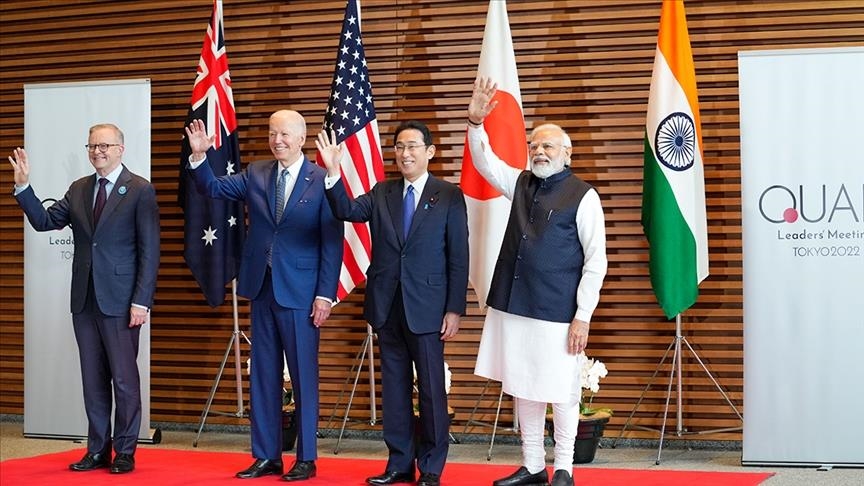Biden revives strategic pivot to Asia to contain China’s influence
New US-led economic grouping for Asia-Pacific comes 5 years after Trump abandoned Trans-Pacific Partnership agreement

ANKARA
US President Joe Biden's announcement of forming a new economic grouping for the Asia-Pacific, including 13 inaugural members, has revived Barack Obama's "pivot" or strategy of rebalancing Asia.
The decision has come five years after Donald Trump had withdrawn from the Trans-Pacific Partnership (TPP) agreement soon after assuming office.
The new grouping accounts for about 40% of the world's gross domestic product (GDP).
The 13 initial members of the group, the Indo-Pacific Economic Framework (IPEF), are the US, Japan, India, South Korea, Australia, Indonesia, Thailand, Singapore, Malaysia, the Philippines, Vietnam, New Zealand, and Brunei, the Biden administration said Monday.
The revival of the economic grouping in Asia is perceived as the revival of the strategy of rebalancing Asia, of which India and Japan at two ends are seen as anchors.
Though IPEF is an economic alliance, like the earlier TPP, the US has left nothing to the imagination that this is meant to counter China's rise through enhanced political and economic cooperation with regional allies.
US Commerce Secretary Gina Raimondo mentioned China in her remarks, saying the launch of the group marks "an important turning point in restoring US economic leadership in the region, and presenting Indo-Pacific countries an alternative to China's approach to the critical issues."
The TPP was a 12-nation trade arrangement that had come up after seven years of negotiations aiming to liberalize the flow of goods amongst the Pacific Rim countries and also to counter China's rise in the region.
It was seen as the signature achievement of Barack Obama's presidency, cutting tariffs on thousands of items and attempting to unify copyright laws across its members.
Speaking at the launch event in Tokyo, Biden said that the future of the 21st Century economy will be written in the Indo-Pacific.
"We're writing the new rules," he said.
New alliance has 4 pillars
According to US officials, the IPEF will focus on deepening cooperation between the US and its Asian partners along four pillars: supply chain resiliency, clean energy and decarbonization, tax and anti-corruption, and trade.
The document circulated at the Tokyo meeting mentioned that the IPEF will focus on four policy pillars that include the connected economy, resilient economy, clean economy, and fair economy.
India, which had earlier withdrawn from the 15-member Regional Comprehensive Economic Partnership (RCEP) -- a free trade agreement of Asia-Pacific nations due to fears over the impact of free trade on its farmers and businesses -- agreed to join the new US-led framework.
The RCEP, which includes China, Japan, South Korea, New Zealand, Australia, and the 10 ASEAN member states – entered into force at the start of 2022.
Raimondo said the countries in the region that have joined the IPEF will have the advantage of getting businesses from American companies as many of them are looking to relocate from China.
Besides reviving the trade alliance that was buried by his predecessor Trump, Biden's Tokyo visit led to discussions on economic and security issues. He pledged $50 billion in developing infrastructure to counter China's rising influence in the region.
He also launched a maritime initiative at the Quadrilateral Security Dialogue, known as the Quad meeting, with India, Japan, and Australia.
The informal alliance set up to respond to China's economic and military might also discuss climate change, technology, COVID-19, as well as the fallout from Russia's invasion of Ukraine.
The new maritime surveillance initiative – the Indo-Pacific Partnership for Maritime Domain Awareness (IPMDA) – will work with regional partners to respond to humanitarian and natural disasters and combat illegal fishing.
Offers jobs and investment
With 60% of the world's population, the Asia-Pacific is projected to be the largest contributor to global growth over the next 30 years.
According to the US National Security Advisor (NSA) Jake Sullivan, the IPEF will support more than three million American jobs and source nearly $900 billion in foreign direct investment for the US economy.
Experts say there are, however, many drawbacks to the IPEF as, unlike RCEP, it does not guarantee free trade between the countries.
According to Aidan Arasasingham, a program coordinator at the Washington-based Center for Strategic and International Studies (CSIS), the lack of enforcement mechanisms and without the promise of greater access to US markets, the agreement will not have incentives for regional partners.
According to Indian officials, they are expecting a ministerial summit of all member countries in mid-summer to carry forward negotiations. They are expecting to conclude the negotiations to pave the way for the signing of an agreement within 12–18 months.
Challenges for new alliance
Since the Asia-Pacific Economic Cooperation (APEC) summit is scheduled around November 2023 in Washington, it could be a deadline for the conclusion of IFEF agreements, believe the CSIS scholars.
Analysts, however, predict challenges as the countries start formal negotiations. They will expect incentives from the US. It remains to be seen the extent of incentives that the US may be able to offer, keeping in view its own domestic economic woes.
India was a member of the RCEP drafting committee from its inception in 2011, but in November 2019, it decided to opt out to protect its domestic industry. It is also believed that a swift opening up of the country's markets to foreign agricultural products may place farmers at a disadvantage.
Anadolu Agency website contains only a portion of the news stories offered to subscribers in the AA News Broadcasting System (HAS), and in summarized form. Please contact us for subscription options.

